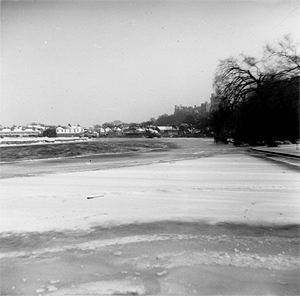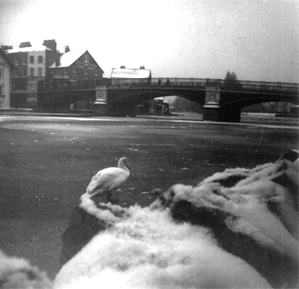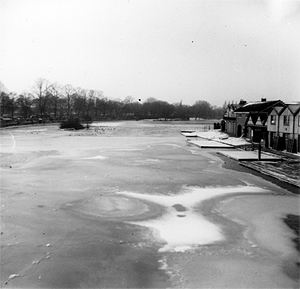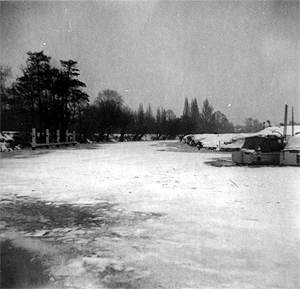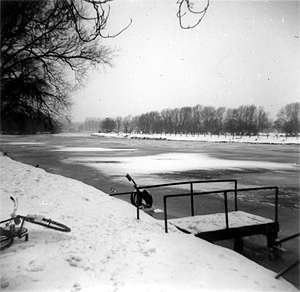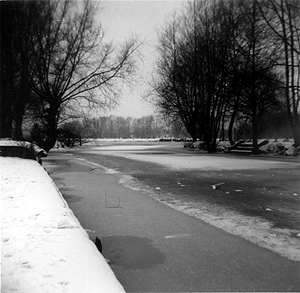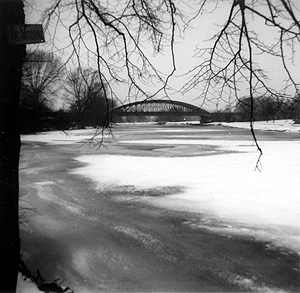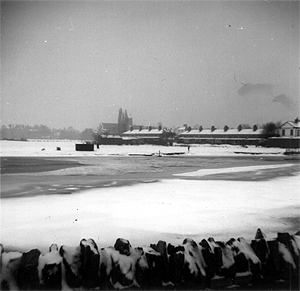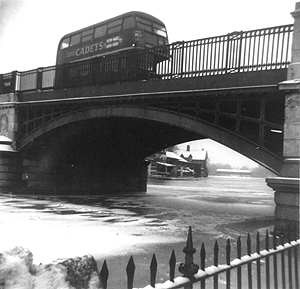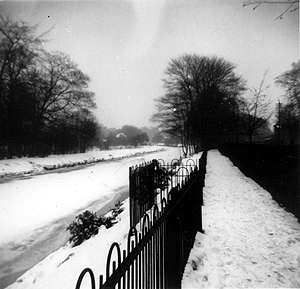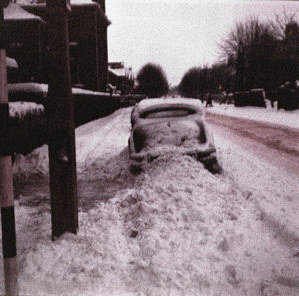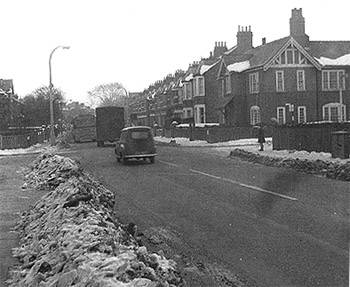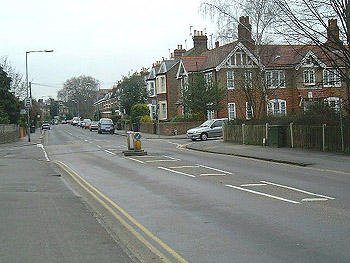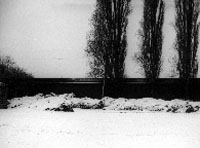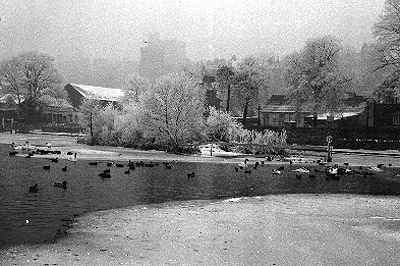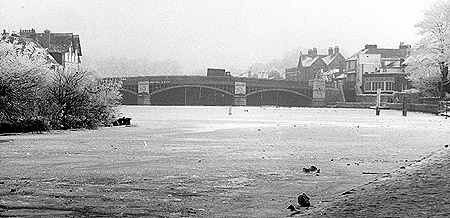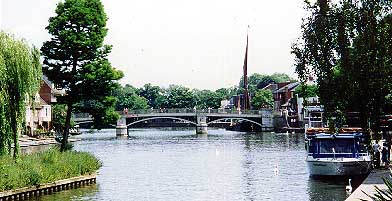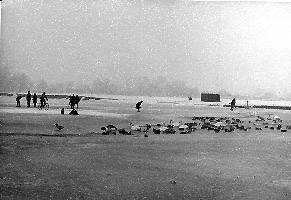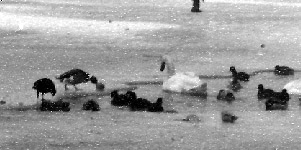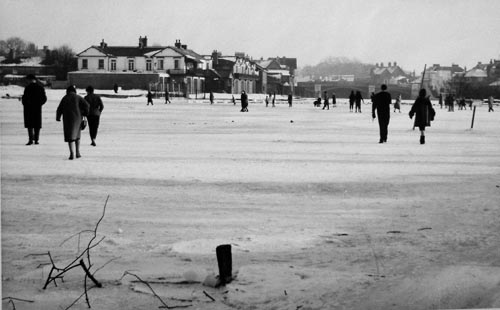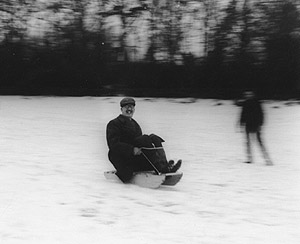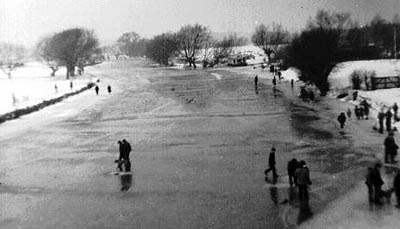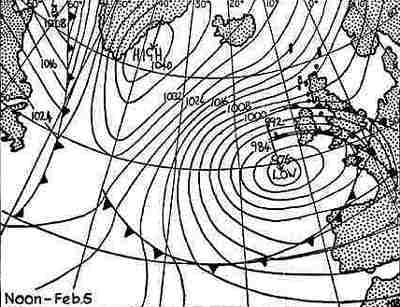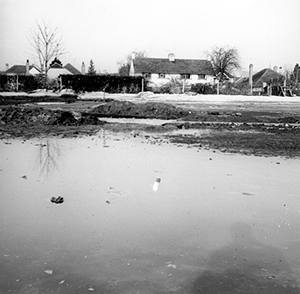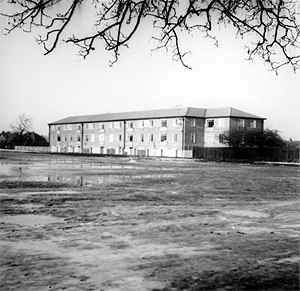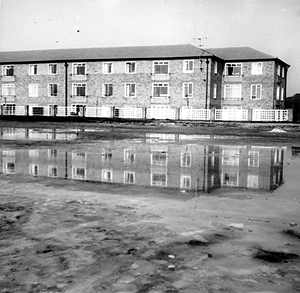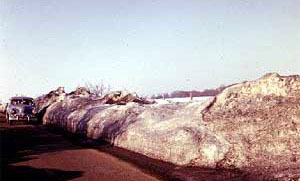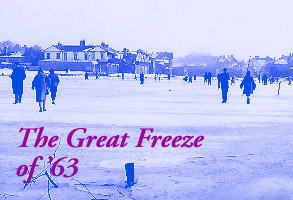
Updated
September 19, 2012
This article was originally
prepared for the web when modem speeds were very slow and pictures
took a long time to arrive. They were therefore made quite small
to speed transmission. Pictures included more recently are larger
and the smaller ones will be increased in size as time permits.
There is a Discussion Forum for The Great Freeze
here
Historical Note - Other
Thames Freezes
This is not intended to be a definitive
list, and is based on reported weather conditions from agricultural
records where the freezing of the Thames was recorded on most
occasions in London.
The intention is however to demonstrate that severe
weather conditions such as described below were not unique and
occurred from time to time on a reasonably regular basis.
Freezes occurred in 1963, 1953, 1947 (the coldest
February ever), 1940, 1895-6, 1893, 1880, 1857 (Source: Leslie
Ward ('SPY' of Vanity Fair) Autobiography, page 17 where he recalls
well that an ox was roasted on the Thames at Eton), 1821, 27
December 1813 - 27 March 1814 (Frost Fair 4th Feb 1814), 24 December
1739 to early March 1740, (Frost Fair Christmas 1739 - February
1740), 1708, 1688, 1685, 1684, 1683, (The winter was 'intolerably
severe' (John Evelyn), Frost Fair), 1665, 1649, 1608, 1607 and
1564. There are earlier records of freezes also back to 1100AD.
|
The Great Freeze of '63
It started
at Christmas time
and lasted through to early March, with record low temperatures
at night, regular snowfalls and thick ice from bank to bank across
the Thames at Windsor and upstream such that thoughts turned
to ox roasts and Frost Fairs on the ice as depicted in paintings
from earlier centuries.
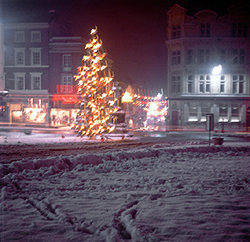 The Christmas Tree
by Queen Victoria Statue.
The Christmas Tree
by Queen Victoria Statue.
New Year Jan 1963
But in the end it was just
strolls on the ice, and bicycle hockey for the school boys, despite
the obvious dangers of falling through the ice.
In this article we recall
events and reminiscences of the hardest winter Windsor has seen
perhaps for a century, using the detailed diaries and contemporary
photographs kept by Gordon Cullingham, Deputy Borough Engineer
for Windsor at the time, and who was closely involved with the
effects of the bad weather around the town.
|
The winter of 1962-63 had
started unremarkably enough, with a dusting of snow on 20th November
followed by milder weather at the end of the month. The first
days of December saw temperatures below freezing all day, despite
the sunshine, followed by thick, often freezing, fog from the
3rd - 6th. The effect on the trees was to cover them all with
'a wonderful frosting'.
As Christmas approached there was nothing particularly
untoward about the weather, some rain, a gale or two, but come
Boxing Day, 26th December, all that was to change when the first
heavy snow fell in the afternoon. It snowed again every day until
the 29th December when blizzards were forecast. The local council
drivers were kept busy salting the roads and, overnight, snow
drifts of up to 3 feet (90cm) accumulated around the town. Car
travel was beginning to be difficult and longer journeys were
postponed in the hope that the weather would clear,
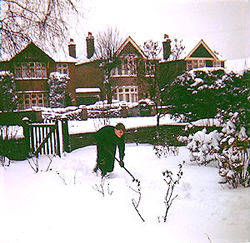
A common sight
around Windsor at New Year, when up to 12" of snow had to
be cleared from paths
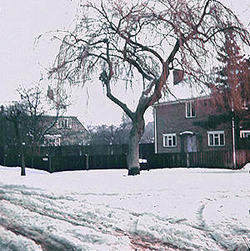
There was not much
chance of side roads being cleared as the main roads regularly
needed attention. A view of York Avenue and York Road.
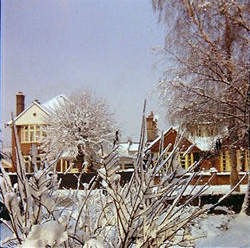 Sunny and snowy
in Clarence Road
Sunny and snowy
in Clarence Road
At New Year there was between
6" and 12" of snow lying and temperatures were regularly
below freezing during the day. Stocks of solid fuel in people's
homes were beginning to run low, with long delivery times. In
a normal winter, deliveries could be expected within a day or
two.
In the early hours of Sunday 30th December there
had been a fire at The Buttery adjacent to Windsor Bridge. A
policeman had seen flames leaping through the roof and raised
the alarm. Soon after the roof collapsed and flames were blown
across the road towards the South Western Hotel (later William
IV Hotel and recently Bell and the Dragon). It was snowing, which
hampered the firemen, especially as the water froze on their
hoses, and traffic had to be diverted because at that time Windsor
Bridge was still the main crossing point between Windsor, Eton
and Slough. The blaze was believed to have started in the top
flat, but water damage affected the entire building, including
Forbes and Francis, the book and record shop at street level.
Although the covers of the LPs were soaked there were many bargains
to be had later in the month when a 'fire sale' was announced.
On the 2nd January there was a further snowfall
of several inches but hopes of better weather rose on the 3rd
when there was a slight thaw that lasted until the 5th.
But then it turned cold again and was to remain
below freezing for several weeks. Boys returning to Windsor Grammar
School in Maidenhead Road on the 8th were sent home as the heating
was not working and threats of power cuts due to industrial action
by power workers was on the cards.
The night of 10th January was the coldest for eight
years, with frost all day once again, and by the 12th ice 'floes'
were forming in the river. Gordon Cullingham witnessed a solitary
skiff being rowed along the river, noisily hitting the chunks
of ice - the Thames was beginning to freeze.
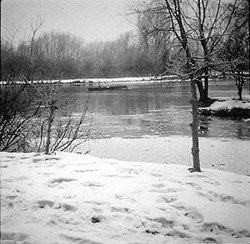 "...a solitary
skiff being rowed along the river, noisily hitting the chunks
of ice"
"...a solitary
skiff being rowed along the river, noisily hitting the chunks
of ice"
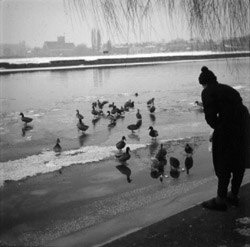 Early days of the
freeze - Feeding the ducks on 13th Jan 1963
Early days of the
freeze - Feeding the ducks on 13th Jan 1963
Picture taken on the promenade adjacent to the café.
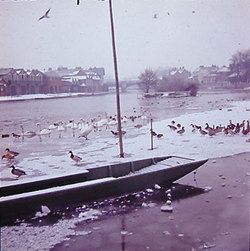
A view from the
promenade on 13th Jan 1963.
The punt belongs to the ferryman who in the summer would take
you across to the Brocas. Although a colour slide, there was
little colour to photograph - see below
In Romney Lock Cut, downstream
of the town, ice had already formed from bank to bank. The water
flow here was much slower - almost stationary - and so ice formed
more readily than in the faster moving weir stream.
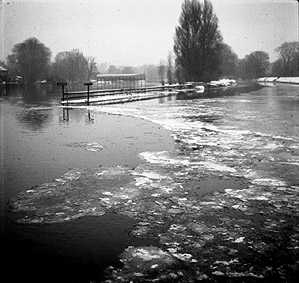 Romney Weir and
the Lock Cut. 13th Jan 1963
Romney Weir and
the Lock Cut. 13th Jan 1963
[Editor's note: This B/W picture is taken from a colour slide
(!)
but it was such a grey day, there was no colour!]
On the 14th
January a slight thaw was noted, together with many burst pipes,
including heating problems once again at the Grammar School and
another day off for the boys!
Around the town much effort had been made on a daily
basis to keep the roads clear, but the problem was that the snow
was just not thawing and it became necessary to shovel it into
lorries and pile it up on open land. Great piles of snow were
dumped by the arches at Baths Island on the site now occupied
by the fun fair.
There were complaints from residents who, having
cleared the piles of snow in front of their drives, were awaking
the next day to find that the snow ploughs had pushed it all
back again!
After five weeks of freezing weather,
the Thames was now frozen right across. The following photographs
were taken on 19th January 1963 and show that ice had formed
right across the river at many points, although in some places
it was not very thick, and certainly not thick enough to walk
on. Despite this, many school boys from both sides of the river
tried and survived to tell the tale...
|






